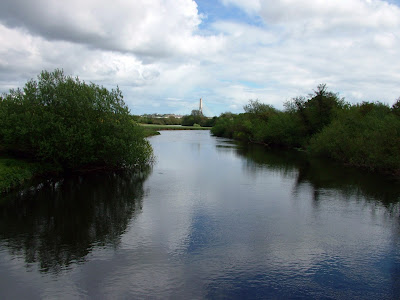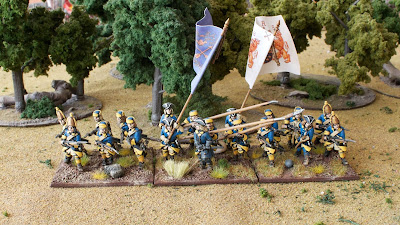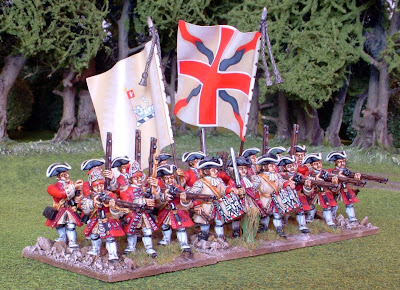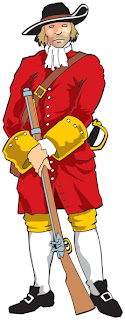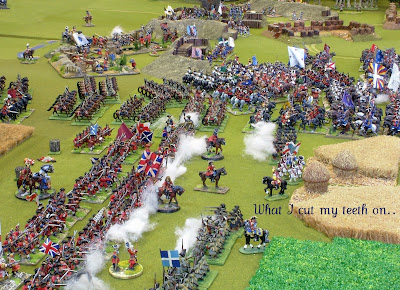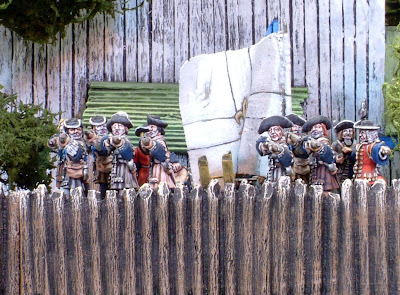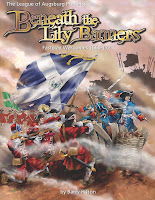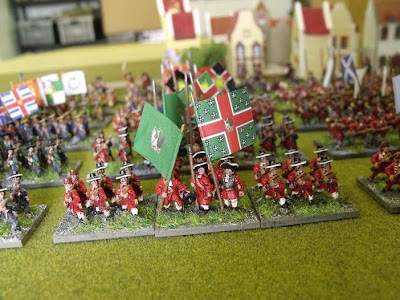Orders of Battle for Regimental Scale Action Using Beneath the Lily Banners, 1644 or Any Other Appropriate Rules System.
The Jacobite ‘Flying camp’ under Justin Macarthy Viscount
Montcashel
Vanguard under Brigadier Anthony Hamilton (Commander rating: Plodder)
Regiment of Dragoons (BLB rating: Raw) 4 squadrons
Regiment of Horse (BLB rating Drilled) 1 squadron
Main Body under Montcashel (Commander rating: Average)
Regiment of Horse (BLB rating Drilled) 1 squadron
Regiment of Foot (BLB rating Raw) with pikes
Regiment of Foot (BLB rating Raw) with pikes
Regiment of Foot (BLB rating Raw) with pikes
Command shot (BLB rating Raw) 2 stands of muskets
Command shot (BLB rating Raw) 2 stands of muskets
OR
![]() |
| unhorsed Jacobite officer |
Regiment of Horse (BLB rating Drilled) 1 squadronMontcashel’s Regiment of Foot (BLB rating Raw) with pikes
Dillon’Regiment of Foot (BLB rating Raw) with pikes
Richard Butler’s Regiment of Foot (BLB rating Raw) with pikes
Fielding’s Regiment of Foot (BLB rating Raw) with pikes
O’ Bryan’s Regiment of Foot (BLB rating Raw) with pikes
2 Light guns (BLB rating Raw)
The Enniskillen Garrison under Colonel Wolseley
Vanguard under Colonel
Berry (Commander rating: Average)
Wolseley’s Horse (BLB rating Raw) 2 squadrons
Wynne’s Dragoons (BLB rating Raw) 2 squadrons
Main Body under Colonel Wolseley (Commander rating: Good)
Zachariah Tiffin’s Regiment of Foot (BLB rating Raw) with pikes
Gustavus Hamilton’s Regiment of Foot (BLB rating Raw) with pikes
Colonel Lloyd’s Regiment of Foot (BLB rating Raw) 3 stands of muskets
Orders of Battle for company scale action using Beneath the Lily Banners, 1644 or any other appropriate rules system of choice.
The Jacobite ‘Flying camp’ under Justin Macarthy Viscount Montcashel
Vanguard under Brigadier Anthony Hamilton (Commander rating: Plodder)
Regiment of Dragoons (BLB rating Raw) 13 troops of 6 figures
Regiment of Horse (BLB rating Drilled) 3 troops of 6 figures
Main Body under Montcashel (Commander rating: Average)
Regiment of Horse(BLB rating Drilled) 3 troops of 6 figures
Regiment of Foot(BLB rating Raw)
3 companies of Foot (2 x 6 figures with muskets, 1 x 6 figures with pikes)
3 companies of Foot (2 x 6 figures with muskets, 1 x 6 figures with pikes)
3 companies of Foot (2 x 6 figures with muskets, 1 x 6 figures with pikes)
3 companies of Foot (2 x 6 figures with muskets, 1 x 6 figures with pikes)
1 company of Foot (1 x 6 figures with muskets)
Regiment of Foot(BLB rating Raw)
3 companies of Foot (2 x 6 figures with muskets, 1 x 6 figures with pikes)
3 companies of Foot (2 x 6 figures with muskets, 1 x 6 figures with pikes)
3 companies of Foot (2 x 6 figures with muskets, 1 x 6 figures with pikes)
3 companies of Foot (2 x 6 figures with muskets, 1 x 6 figures with pikes)
1 company of Foot (1 x 6 figures with muskets)
Regiment of Foot(BLB rating Raw)
3 companies of Foot (2 x 6 figures with muskets, 1 x 6 figures with pikes)
3 companies of Foot (2 x 6 figures with muskets, 1 x 6 figures with pikes)
3 companies of Foot (2 x 6 figures with muskets, 1 x 6 figures with pikes)
3 companies of Foot (2 x 6 figures with muskets, 1 x 6 figures with pikes)
1 company of Foot (1 x 6 figures with muskets) OR
Montcashel’s Regiment of Foot (BLB rating Raw)3 companies of Foot (2 x 6 figures with muskets, 1 x 6 figures with pikes)
3 companies of Foot (2 x 6 figures with muskets, 1 x 6 figures with pikes)
3 companies of Foot (2 x 6 figures with muskets, 1 x 6 figures with pikes)
1 company of Foot (1 x 6 figures with muskets)
Dillon’s Regiment of Foot (BLB rating Raw)
3 companies of Foot (2 x 6 figures with muskets, 1 x 6 figures with pikes)
3 companies of Foot (2 x 6 figures with muskets, 1 x 6 figures with pikes)
3 companies of Foot (2 x 6 figures with muskets, 1 x 6 figures with pikes)
1 company of Foot (1 x 6 figures with muskets)
Fielding’s Regiment of Foot (BLB rating Raw)
3 companies of Foot (2 x 6 figures with muskets, 1 x 6 figures with pikes)
3 companies of Foot (2 x 6 figures with muskets, 1 x 6 figures with pikes)
3 companies of Foot (2 x 6 figures with muskets, 1 x 6 figures with pikes)
1 company of Foot (1 x 6 figures with muskets)
O’Bryan’s Regiment of Foot (BLB rating Raw)
3 companies of Foot (2 x 6 figures with muskets, 1 x 6 figures with pikes)
3 companies of Foot (2 x 6 figures with muskets, 1 x 6 figures with pikes)
3 companies of Foot (2 x 6 figures with muskets, 1 x 6 figures with pikes)
1 company of Foot (1 x 6 figures with muskets)
Butler’s Regiment of Foot (BLB rating Raw)
3 companies of Foot (2 x 6 figures with muskets, 1 x 6 figures with pikes)
3 companies of Foot (2 x 6 figures with muskets, 1 x 6 figures with pikes)
3 companies of Foot (2 x 6 figures with muskets, 1 x 6 figures with pikes)
1 company of Foot (1 x 6 figures with muskets)
2 Light guns (BLB rating Raw)
The Enniskillen Garrison under Colonel Wolseley
Vanguard under Colonel Berry (Commander rating: Average)
Wolseley’s Regiment of Horse (BLB rating Raw) 6 troops of 6 figures
Wynne’s Regiment of Dragoons (BLB rating Raw) 6 troops of 6 figures
Main Body under Colonel Wolseley (Commander rating: Good)
Zachariah Tiffin’s Regiment of Foot (BLB rating Raw)
3 companies of Foot (2 x 6 figures with muskets, 1 x 6 figures with pikes)
3 companies of Foot (2 x 6 figures with muskets, 1 x 6 figures with pikes)
3 companies of Foot (2 x 6 figures with muskets, 1 x 6 figures with pikes)
1 company of Foot (1 x 6 figures with muskets)
Gustavus Hamilton’s Regiment of Foot (BLB rating Raw)
3 companies of Foot (2 x 6 figures with muskets, 1 x 6 figures with pikes)
3 companies of Foot (2 x 6 figures with muskets, 1 x 6 figures with pikes)
3 companies of Foot (2 x 6 figures with muskets, 1 x 6 figures with pikes)
1 company of Foot (1 x 6 figures with muskets)
Colonel Lloyd’s Regiment of Foot (BLB rating Raw)
3 companies of Foot (2 x 6 figures with muskets, 1 x 6 figures with pikes)
3 companies of Foot (2 x 6 figures with muskets, 1 x 6 figures with pikes)
3 companies of Foot (2 x 6 figures with muskets, 1 x 6 figures with pikes)
1 company of Foot (1 x 6 figures with muskets)
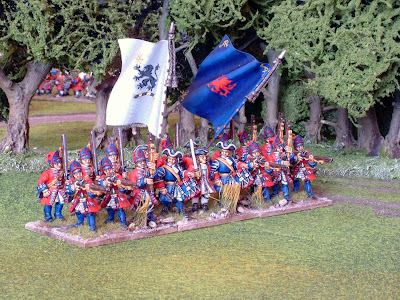.jpg)
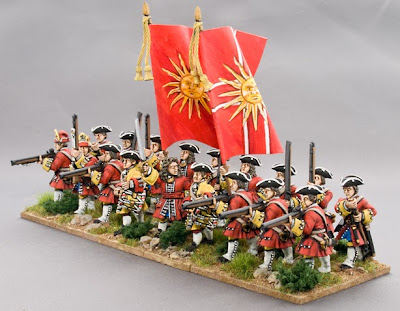.jpg)











